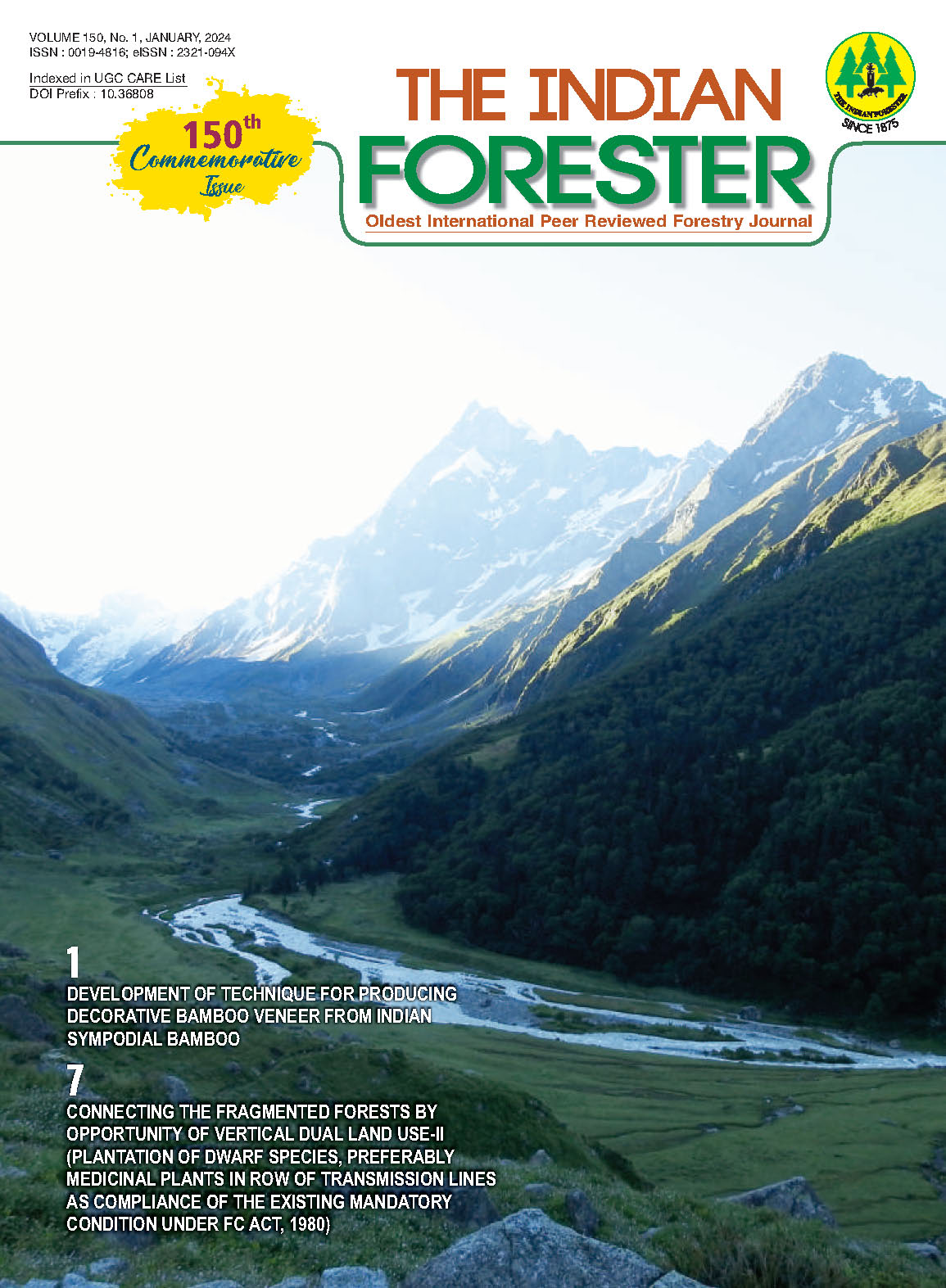Variability for Morphological Traits, Oil and Chemical Constituents Content in Azadirachta indica A. Juss. (Neem) Seeds
DOI:
https://doi.org/10.36808/if/2024/v150i1/169777Keywords:
Azadirachta indica, Seed, Morphological Traits, Oil, Fatty Acid, Limonoids.Abstract
A study on the variation of morphological traits, oil yield and chemical constituents' content (i.e., fatty acids, azadirachtin, nimbin and salanin) of the Azadirachta indica (Neem) seeds has been attempted. Seed samples were collected from candidate plus trees grown in nine different locations of Tamil Nadu and Puducherry. The morphological traits (i.e., seed length, seed width, 100-seed weight, seed kernel ratio) of seeds were measured as per standard procedure while the oil was extracted using the solvent extraction method. Estimation of fatty acids (viz. oleic acid, stearic acid, palmitic acid, linoleic acid, arachidic acid) was carried out by using Gas chromatography/Mass spectrometry (GC/MS), whereas limonoids (i.e., azadirachtin, nimbin and salanin) were estimated by high-performance liquid chromatography (HPLC). Seed morphological traits varied from 13.56 to 18.61 mm, 6.19 to 7.51 mm, 18.07 to 45.71 g and 1.93 to 3.18 for seed length, seed width, 100-seed weight and seed kernel ratio respectively. The average oil yield value ranged from 30.45% to 42.99%. The variations in fatty acid composition (i e., oleic acid 41.41% to 50.52%; stearic acid 16.56% to 21.79%; palmitic acid 17.44% to 19.64%; linoleic acid 11.49% to 18.55%; and arachidic acid 0.30% to 1.80%) were observed. The variations in azadirachtin, nimbin and salanin content were ranged from 4.63 to 9.82 mg/g, 2.40 to 7.34 mg/g and 3.91 to 13.63 mg/g of seed kernels, respectively. Results indicate that there was no relationship between the seed traits, oil yield and chemical constituent's content. As considerable variation exists in the population for oil content, chemical constituents and seed traits, therefore due care has to be taken while selecting superior genotypes.References
Acharya P., Ahmad M.S. and Nayak B. (2017). Competence of Biopesticide and Neem in Agriculture. International Journal of Environment, Agriculture and Biotechnology, 2(6): 2958-2964. http://dx.doi. org/10.22161/ijeab/2.6.23.
Akhila A. and Rani K. (1999). Chemistry of the Neem Tree (Azadirachta indica A. Juss). Fortschritte der Chemie Organischer Naturstoffe, 78: 47-149. https://doi.org/10.1007/978-3-7091-6394-8_2.
Akihisa T., Noto T., Takahashi A., Fujita Y., Banno N., Tokuda H., Koike K., Suzuki T., Yasukawa K. and Kimura Y. (2009). Melanogenesis inhibitory, anti-inflammatory, and chemopreventive effects of limonoids from the seeds of Azadirachta indica A. Juss. (neem). Journal of Oleo Science, 58(11): 581-594. https://doi.org/10.5650/jos.58.581.
Campos E.V. R., de Oliveira J. L., Pascoli M., de Lima R. and Fraceto L. F. (2016). Neem oil and crop protection: from now to the future. Frontiers in Plant Science, 7: 1494. https://doi.org/10.3389/fpls.2016.01494.
Johnson S. and Morgan E.D. (1997). Supercritical fluid extraction of oil and triterpenoids from neem seeds. Phytochemical Analysis, 8: 228-232. https://doi.org/10.1002/(SICI)1099-1565(199709/10) 8:5<228::AID-PCA367>3.0.CO;2-C.
Kaushik A., Tanwar R. and Kaushik M. (2012). Ethnomedicine: Applications of Neem (Azadirachta indica) in dentistry. Dental Hypotheses, 3(3): 112-114. https://doi.org/10.4103/2155-8213.103933.
Kaushik N. and Vir S. (2000). Variations in fatty acid composition of neem seeds collected from the Rajasthan state of India. Biochemical Society Transactions, 28(6): 880-882.
Khalid S.A., Duddeck H. and Gonzalez-Sierra M. (1989). Isolation and characterization of an antimalarial agent of the neem tree Azadirachta indica. Journal of Natural Products, 52(5): 922-927. https://doi.org/10.1042/bst0280880.
Kumar Ch. S.S.R., Srinivas M. and Yakkundi S. (1996). Limonoids from the seeds of Azadirachta indica. Phytochemistry, 43: 451-455. https://doi.org/10.1016/0031-9422(96)00226-9.
Kundu S.K. and Tigerstedt P.M.A. (1997). Geographical variation in seed and seedling traits of neem (Azadirachta indica A. Juss.) among ten populations studied in growth chamber. Silvae Genetica, 46(2): 129-136.
Maneerat W., Laphookhieo S., Koysomboon S. and Chantrapromma K. (2008). Antimalarial, antimycobacterial and cytotoxic limonoids from Chisocheton siamensis. Phytomedicine, 15(12): 1130-1134. https://doi.org/ 10.1016/j.phymed.2008.05.004.
Mansouri A., Mirzabe A.H. and Raufi A. (2017). Physical properties and mathematical modeling of melon (Cucumis melo L.) seeds and kernels. Journal of theSaudiSociety ofAgricultural Sciences, 16(3): 218-226. https://doi.org/10.1016/ j.jssas.2015.07.001.
Melwita E. and Ju Y.H. (2010). Separation of azadirachtin and other limonoids from crude neem oil via solvent precipitation. Separation and Purification Technology, 74(2): 219-224. https://doi.org/10.1016/j.seppur.2010.06.008.
Moin M.S., Siddiqui J.I., Alam M.A., Khatoon F., Khan S. and Minhajuddin A. (2021). Ethnomedicinal potential of widely used plant Azadirachta indica A. Juss: A comprehensive review. The Journal of Phytopharmacology, 10(6): 456-467.
Mongkholkhajornsilp D., Douglas S., Douglas P.L., Elkamel A., Teppaitoon W. and Pongamphai S. (2005). Supercritical CO2 extraction of nimbin from neem seeds—a modelling study. Journal of Food Engineering, 71(4): 331-340. https://doi.org/10.1016/j.jfoodeng.2004.08.007.
Orhevba B.A., Chukwu O., Osunde Z.D. and Ogwuagwu V. (2013). Influence of Moisture Content on the Yield of Mechanically Expressed Neem Seed Kernel Oil. Academic Research International, 4(5): 252-257.
Paul R., Prasad M. and Sah N.K. (2011). Anticancer biology of Azadirachta indica L (neem): a mini review. Cancer biology and therapy, 12(6): 467-476. https://doi.org/10.4161/cbt.12.6.16850.
Prabakaran P., Kumaran K., Baburaj L.K., Balaji S., Mageshram S., Balakumar C. and Radhakrishnan R. (2019). Variability Studies on Seed Parameters, Oil and Azadirachtin Content of Neem (Azadirachta indica A. Juss.) in Tamil Nadu and Karnataka. International Journal of Current Microbiology and Applied Sciences, 8(5): 339-346. https://doi.org/10.20546/ijcmas.2019.805.040.
Sniezko R.A. and Stewart H.T.L. (1989). Range-wide provenance variation in growth and nutrition of Acacia albida seedlings propagated in Zimbabwe. Forest Ecology and Management, 27(3-4): 179-197. https://doi.org/10.1016/0378-1127(89)90106-0.
Tan Q.G. and Lou X.D. (2011). Meliaceous limonoids: chemistry and biological activities. Chemical Reviews, 111(11): 7437-7522. https://doi.org/10.1021/cr9004023.
Tomar A., Singh K.K., Phogat S and Dhillon R.S. (2008). Neem : An introduction. IK International Publishing House Pvt. Ltd., in Neem : ATreatise : 546
Downloads
Downloads
Published
How to Cite
Issue
Section
License
Unless otherwise stated, copyright or similar rights in all materials presented on the site, including graphical images, are owned by Indian Forester.





